11.6 PROBLEMS
Question 11.9
Changes in the prices of key commodities can have a significant impact on a company’s bottom line. According to a September 27, 2007, article in the Wall Street Journal, “Now, with oil, gas and electricity prices soaring, companies are beginning to realize that saving energy can translate into dramatically lower costs.” Another Wall Street Journal article, dated September 9, 2007, states, “Higher grain prices are taking an increasing financial toll.” Energy is an input into virtually all types of production; corn is an input into the production of beef, chicken, high-
Explain how the cost of energy can be both a fixed cost and a variable cost for a company.
Suppose energy is a fixed cost and energy prices rise. What happens to the company’s average total cost curve? What happens to its marginal cost curve? Illustrate your answer with a diagram.
Explain why the cost of corn is a variable cost but not a fixed cost for an ethanol producer.
When the cost of corn goes up, what happens to the average total cost curve of an ethanol producer? What happens to its marginal cost curve? Illustrate your answer with a diagram.
Question 11.10
Marty’s Frozen Yogourt is a small shop that sells cups of frozen yogourt in a university town. Marty owns three frozen-

What are the fixed inputs and variable inputs in the production of cups of frozen yogourt?
Draw the total product curve. Put the quantity of labour on the horizontal axis and the quantity of frozen yogourt on the vertical axis.
What is the marginal product of the first worker? The second worker? The third worker? Why does marginal product decline as the number of workers increases?
What is the average product of labour when there are 2 workers? 3 workers? 4 workers? Why does average product decline as the number of workers increases?
Question 11.11
The production function for Marty’s Frozen Yogourt is given in Problem 2. Now suppose that, with experience, Marty’s workers learn how to make frozen yogourt faster. As a result, their productivity increases by 20%.
Draw the initial and new total product curves. Put the quantity of labour on the horizontal axis and the quantity of frozen yogourt on the vertical axis. What happens to the total product curve?
What are the marginal product and average product for the workers in Marty’s Frozen Yogourt after the productivity improvement?
Draw the initial and new marginal product and average product curves. Put the quantity of labour on the horizontal axis and the quantity of frozen yogourt on the vertical axis. What happens to the marginal product curve? What happens to the average product curve?
Question 11.12
The production function for Marty’s Frozen Yogourt is given in Problem 2. Marty pays each of his workers $80 per day. The cost of his other variable inputs is $0.50 per cup of yogourt. His fixed cost is $100 per day.
What is Marty’s variable cost and total cost when he produces 110 cups of yogourt? 200 cups? Calculate variable and total cost for every level of output given in Problem 2.
Draw Marty’s variable cost curve. On the same diagram, draw his total cost curve.
What is the marginal cost per cup for the first 110 cups of yogourt? For the next 90 cups? Calculate the marginal cost for all remaining levels of output.
Question 11.13
The production function for Marty’s Frozen Yogourt is given in Problem 2. The costs are given in Problem 4.
For each of the given levels of output, calculate the average fixed cost (AFC), average variable cost (AVC), and average total cost (ATC) per cup of frozen yogourt.
On one diagram, draw the AFC, AVC, and ATC curves.
What principle explains why the AFC declines as output increases? What principle explains why the AVC increases as output increases? Explain your answers.
How many cups of frozen yogourt are produced when average total cost is minimized?
Question 11.14
The accompanying table shows a car manufacturer’s total cost of producing cars.
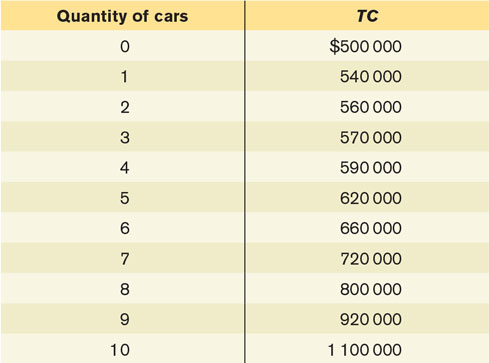
What is this manufacturer’s fixed cost?
For each level of output, calculate the variable cost (VC). For each level of output except zero output, calculate the average variable cost (AVC), average total cost (ATC), and average fixed cost (AFC). What is the minimum-
cost output? For each level of output, calculate this manufacturer’s marginal cost (MC).
On one diagram, draw the manufacturer’s AVC, ATC, and MC curves.
Question 11.15
Labour costs represent a large percentage of total costs for many firms. According to Statistics Canada, Canada’s labour costs were up by 2.98% from 2011 to 2012.
When labour costs increase, what happens to average total cost and marginal cost? Consider a case in which labour costs are only variable costs and a case in which they represent a portion of both variable and fixed costs.
An increase in labour productivity means each worker can produce more output. Recent data on productivity show that labour productivity in the Canadian business sector grew annually by 1.5% between 1991 and 1999, by 1.0% between 2000 and 2009, and by 0.85% between 2010 and 2012.
When productivity growth is positive, what happens to the total product curve and the marginal product of labour curve? Illustrate your answer with a diagram.
When productivity growth is positive, what happens to the marginal cost curve and the average total cost curve? Illustrate your answer with a diagram.
If labour costs are rising over time on average, why would a company want to adopt equipment and methods that increase labour productivity?
Question 11.16
Magnificent Blooms is a florist specializing in floral arrangements for weddings, graduations, and other events. Magnificent Blooms has a fixed cost associated with space and equipment of $100 per day. Each worker is paid $50 per day. The daily production function for Magnificent Blooms is shown in the accompanying table.
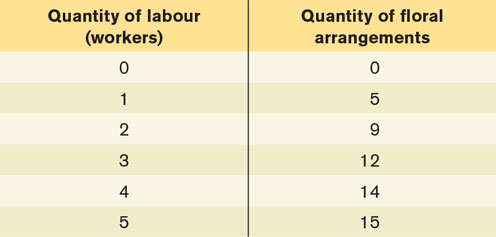
Calculate the marginal product of each worker. What principle explains why the marginal product per worker declines as the number of workers employed increases?
Calculate the marginal cost of each level of output. What principle explains why the marginal cost per floral arrangement increases as the number of arrangements increases?
Question 11.17
You have the information shown in the accompanying table about a firm’s costs. Complete the missing data.
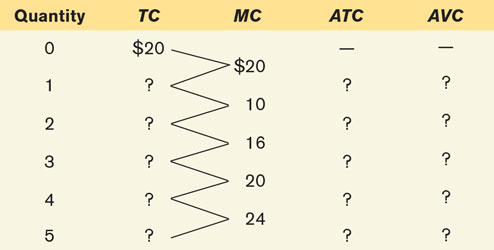
Question 11.18
Evaluate each of the following statements. If a statement is true, explain why; if it is false, identify the mistake and try to correct it.
A decreasing marginal product tells us that marginal cost must be rising.
An increase in fixed cost increases the minimum-
cost output. An increase in fixed cost increases marginal cost.
When marginal cost is above average total cost, average total cost must be falling.
Question 11.19
Husain and Sami operate a small company that produces souvenir footballs. Their fixed cost is $2000 per month. They can hire workers for $1000 per worker per month. Their monthly production function for footballs is as given in the accompanying table.
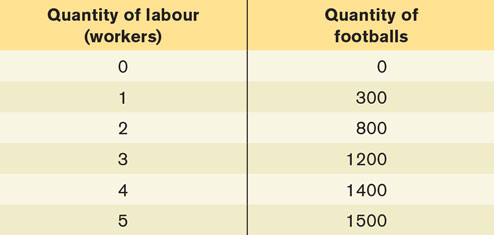
For each quantity of labour, calculate average variable cost (AVC), average fixed cost (AFC), average total cost (ATC), and marginal cost (MC).
On one diagram, draw the AVC, ATC, and MC curves.
At what level of output is Husain and Sami’s average total cost minimized?
Question 11.20
You produce widgets. Currently you produce 4 widgets at a total cost of $40.
What is your average total cost?
Suppose you could produce one more (the fifth) widget at a marginal cost of $5. If you do produce that fifth widget, what will your average total cost be? Has your average total cost increased or decreased? Why?
Suppose instead that you could produce one more (the fifth) widget at a marginal cost of $20. If you do produce that fifth widget, what will your average total cost be? Has your average total cost increased or decreased? Why?
Question 11.21
In your economics class, each homework problem set is graded on the basis of a maximum score of 100. You have completed 9 out of 10 of the problem sets for the term, and your current average grade is 88. What range of grades for your 10th problem set will raise your overall average? What range will lower your overall average? Explain your answer.
Question 11.22
Don owns a small concrete-

For each level of fixed cost, calculate Don’s total cost for producing 20, 40, and 60 orders per week.
If Don is producing 20 orders per week, how many trucks should he purchase and what will his average total cost be? Answer the same questions for 40 and 60 orders per week.
Question 11.23
Consider Don’s concrete-
Suppose that, in the short run, business declines to 20 orders per week. What is Don’s average total cost per order in the short run? What will his average total cost per order in the short run be if his business booms to 60 orders per week?
What is Don’s long-
run average total cost for 20 orders per week? Explain why his short- run average total cost of producing 20 orders per week when the number of trucks is fixed at 3 is greater than his long- run average total cost of producing 20 orders per week. Draw Don’s long-
run average total cost curve. Draw his short- run average total cost curve if he owns 3 trucks.
Question 11.24
True or false? Explain your reasoning.
The short-
run average total cost can never be less than the long- run average total cost. The short-
run average variable cost can never be less than the long- run average total cost. In the long run, choosing a higher level of fixed cost shifts the long-
run average total cost curve upward.
Question 11.25
Wolfsburg Wagon (WW) is a small automaker. The accompanying table shows WW’s long-
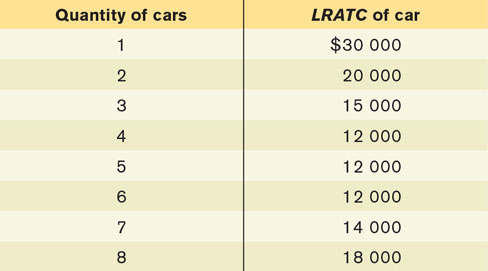
For which levels of output does WW experience increasing returns to scale?
For which levels of output does WW experience decreasing returns to scale?
For which levels of output does WW experience constant returns to scale?